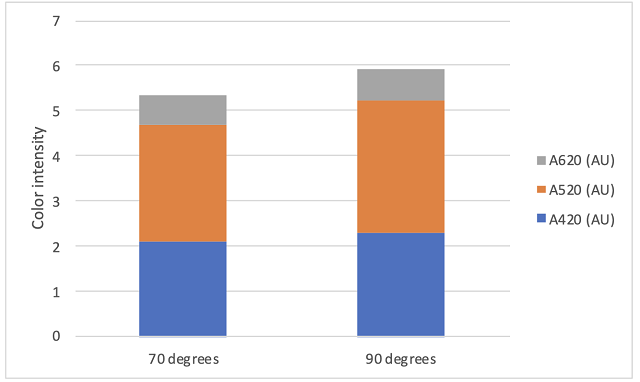Effect of Different Fermentation Temperature in Cab Franc
Lee Hartman
Bluestone Vineyards
Summary
In this experiment, Cabernet Franc was fermented at two different temperatures roughly 20°F apart from one another. There were no large differences in general chemistry nor phenolic measurements. Group sensory analysis was not done due to restrictions put in place during COVID-19. The winemaker notes that the cooler fermentation produced a fruitier, more aromatic wine while the warmer fermentation produced wine with a more extracted character.
Introduction
Literature sources recommend fermentation in red wines generally range from 68-86 degrees. Lower temperatures are credited with higher complexity, less loss of volatile compounds and potentially lower H2S production while higher temperatures are credited with higher extraction of color and tannins from skins and less risk of a stuck fermentation. This study aims to compare the chemical and sensory properties of wine fermented at temperatures at two extremes of this spectrum:
Low temperature (approximately 70 degrees)
High temperature (approximately 90 degrees)
Methods
At the time of harvest, fruit was divided evenly and randomly between two Tbins, one which was fermented at low temperature (70 degrees) and one which was fermented at high temperature (up to 90 degrees). Care was taken to make sure fruit came from the same height on the hill, due to long rows in the vineyard, and the same weight (1800 lbs) was loaded into each bin. Fruit was processed the same for each bin, according to the standard protocols of the winery.
Fruit was destemmed into bins with the addition of 40 ppm SO2, 80 mL/ton Colorpro, 30 g/hL FT Rouge, 4 lbs/ton French oak chips, and 30 g/hL OptiRed then chilled overnight. The following morning, bins were brought outside to warm, then inoculated with 20 g/hL CSM and 15 g/hL Go Ferm in the evening.
The temperature of each bin was measured after each punchdown, in the morning and shortly after lunch. If cooling was needed, bins were moved to a refrigerated cold room. Sun and shade were also used for temperature regulation. The low temperature lot was maintained near a target of 70°F while the high temperature lot was allowed to ferment without regulation unless the fermentation rose above 90°F, at which time temperature control was used to bring temperatures below 90°F. Tartaric acid was added as soon as a cap had formed. Fermaid O was added at 1/3 Brix depletion. Both lots were pressed the same day after 3 weeks total since destemming.
Wine was settled in tank and transferred to identical barrels. Wine was inoculated for malolactic fermentation with VP41 at the recommended rate. Malic acid depletion will be monitored by CO2 emission, then confirmed enzymatically. When malic acid was depleted, 50 ppm SO2 was added without racking.
Results
Unfortunately, fruit metrics are not available, as samples began fermentation during shipping. Fermentation progressed steadily and wines were pressed as soon as both fermentations were complete. Both lots were sugar dry (glucose/fructose was less than 1.0 g/L) and malolactic fermentation was complete (malic acid less than 0.15 g/L) by the end of February. Finished wine chemistry was very similar regardless of thermal regime (Table 1). The wine fermented at higher temperature had slightly better color (Figure 1). There were no large differences in anthocyanins (Table 2) or phenolics (Table 3) between temperature treatments.
The winemaker notes that the cooler fermentation produced a fruitier, more aromatic wine while the warmer fermentation produced wine with a more extracted character.
Table 1: Finished wine chemistry for Cabernet Franc fermented with two thermal regimes (ICV labs)

Figure 1: Color metrics for Cabernet Franc fermented with two thermal regimes (ICV labs)

Table 2: Anthocyanins found in Cabernet Franc fermented with two thermal regimes (ETS labs)

Table 3: Phenolic compounds found in Cabernet Franc fermented with two thermal regimes (ETS labs)

